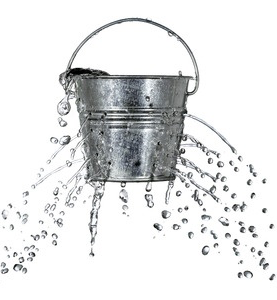Why your sales funnel needs to leak from the top, not the bottom
January 13, 2015

 Let’s face it, every sales funnel leaks. It’s just that some seem to leak more than others - and many are leaking in all the wrong places. It’s a particular challenge in complex sales environments, where significant effort has to be expended to get any deal over the goal line.
Let’s face it, every sales funnel leaks. It’s just that some seem to leak more than others - and many are leaking in all the wrong places. It’s a particular challenge in complex sales environments, where significant effort has to be expended to get any deal over the goal line.
The effort and resources that goes into opportunities that are eventually lost to a competitor, or to a decision to “do nothing” cannot usually be recovered. Now, some measure of wastage has to be expected - but a significant amount of that waste could be avoided.
In complex sales pipelines around the world, there is a substantial proportion of opportunities that are destined to be lost or abandoned. What we need to do is to recognise them early, before we’ve invested a bunch of unnecessary time and effort in them...
If you're destined to lose, you had better lose early
One of my most respected sales mentors told me years ago that “if you’re destined to lose, you had better lose early”. It’s a principle that resonates with most people - but it’s also harder to put into practice than might first appear
The idea requires a level of discipline that is unnatural to many middle-of-the road sales people. They have been schooled to believe that bigger pipelines are always better, and their sales managers have often been reinforcing the misconception.
They have been programmed to cling on to poorly qualified opportunities like a drowning man clinging to a piece of soggy timber in a storm swept sea. And as a result, they fritter away their time on “opportunities” that by any rational analysis have little chance of closing.
The benefits of ruthless qualification
Top performing sales people - at least according to my observations - behave very differently. They have too much respect for their own time to fritter it away on opportunities that are never likely to close. They qualify hard, and they qualify early.
Some top sales managers have an equally rigorous approach. One of the most effective sales leaders I ever worked with used to insist that their sales people regularly rejustify - with tangible evidence - why they should still be working on any given opportunity.
He was particularly ruthless about the often fatally attractive big opportunities - often requiring a detailed RFP response - that were going to require the organisation to invest significant amounts of time, energy and resources on the sales process.
In fact, he insisted that the default reaction to receiving an RFP was to politely decline to bid if the sales person had played no prior active role in shaping the requirements - unless the prospect was open to a re-examination of their underlying needs.
At the end of the day, it’s all about qualification. But the traditional “BANT” formula is no miracle cure, for the reasons I describe here. Here are a few of the key elements that I urge you to consider:
1: Is the organisation a good fit against our perfect customer profile?
If you’re selling into a high-value, considered-purchase environment, it’s inevitable that the market will include a subset of organisations that are far more likely to do business with you (and much more likely to become good long-term customers) than the rest.
The classic demographics of size, sector and location are entirely inadequate to describe them. If you look hard enough, there is always a set of common structural, behavioural or environmental indicators that set these high-potential organisations apart.
You’ve got to target your demand generation activities at these “ideal prospects”, and at the issues and values that are important to them. And, early on in the sales cycle, you’ve got to qualify whether any given opportunity is a good enough match to your target organisation profile.
2: Is our contact a likely mobiliser?
It’s awfully easy to enter into agreeable and apparently productive conversations with people who have no power to influence their organisation. From a very early stage, your sales people need to determine whether their contact has the influence and authority to mobilise the rest of the organisation around a decision to implement your solution.
If not, they need to deliberately, intentionally and urgently use their current contact as a springboard to reach the people with the real power who can make things happen. The most important thing you need to discover is whether the person you’re talking to has a proven track record of making successful change happen within their organisation.
Alternatively, if they are a new appointment to the role, you’re looking for evidence that they were appointed with a charter for change, and have a track record of successful change in their previous positions.
3: Is the need business critical?
Organisations (and individuals, for that matter) always have far many more “needs” than they could possibly hope to satisfy or address. Interesting needs might get prospects to investigate you. Important needs might get them to evaluate you. But only business critical needs guarantee they will inevitably have to take action.
One of the best ways of testing this is by exploring the consequences of inaction. If they cannot associate a set of significant tangible negative consequences with a decision to stick with the status quo, then the chances that they will actually do something are dramatically diminished.
And remember that pain is relative. Even if your solution offers an apparently compelling ROI, then faced with a problem that is even more painful, they will decide to invest in that instead. You’ve got to prove (and amplify, if possible) the pain before you promote your gain.
4: Is there a strong solution fit?
The final thing I recommend you pay attention to is solution fit. Even if the organisation is a good one, the contact a powerful one, and the need a business critical one, those factors count for little if you can’t prove a strong solution fit.
You’ve got to assume that the prospect will do their research. If there is an obviously superior way of solving their problem, you’ve got to anticipate that they will identify it. So your sales people should focus their energies on opportunities where you can demonstrate a provably superior solution fit.
Get your sales people to regularly rejustify every opportunity
A more forensic approach at the top of the funnel can prevent “no hoper” deals getting swept into the body of your sales pipeline, only for them to be inevitably lost or abandoned later on. I recommend that you take the default position that opportunities be qualified out unless there is clear positive evidence they should be qualified in.
To conclude with another watery metaphor, doesn’t this mean that the baby might occasionally be thrown out with the bath water? If it happens, it will happen very rarely. And it will be more than compensated for by the resources you can now apply to uncovering and closing far better qualified opportunities.



Comments